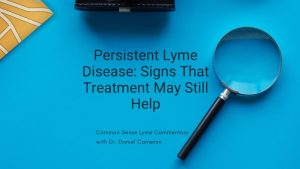Call for your appointment today 914-666-4665 | Mt. Kisco, New York

The authors collected data via an online questionnaire from 252 Lyme disease patients and a control group of 267 healthy individuals living in Germany to examine the clinical presentation, including neuropsychiatric and psychological symptoms.
The findings revealed that “Lyme disease can cause diverse psychological and neuropsychiatric symptoms. These include limitations in quality of life, sleep, attention, and memory, as well as depressive symptoms.”
Time to diagnosis
The majority of the patients were diagnosed with Lyme disease based on ELISA (53.2%), Western blot (43.7%), and lymphocyte transformation test results (41.7%).
Out of the 252 participants, nearly half (45.5%) recalled an erythema migrans rash, while 74% recalled a tick bite “that possibly triggered Lyme disease.”
It took approximately 8 years to receive a diagnosis following the tick bite.
On average, patients visited almost 8 physicians to obtain a diagnosis.
It took approximately 8 years to receive a diagnosis following the tick bite. Less than half (46%) received their diagnosis within the first 5 years after the onset of symptoms.
Co-infections
The majority of participants were not diagnosed with or tested for a co-infections.
“A total of 25% of the sample stated that they had (exactly one) co-infection,” the authors explain, while 15% reported having 2 co-infections.
“For patients that suffered from co-infections, Chlamydia infection was particularly common (34.9%), as was the Epstein–Barr virus (34.9%).”
Treatment
Out of the 252 participants, 168 received antibiotic treatment that lasted at least 3 weeks.
Symptoms improved for nearly 73% of these patients.
93% of participants reported a relapse of symptoms after the completion of antibiotic therapy.
“The type of treatment was oral in most cases (47.6%), or a combination of oral and intravenous therapy (48.8%),” according to the authors.
Intravenous antibiotic therapy was prescribed in only 3.6% of the cases.
Authors Conclude:
- “It became clear that Lyme disease is often diagnosed very late.”
- “It appears that people suffering from Lyme disease have significantly lower quality of life and sleep and show cognitive impairments when it comes to attention and memory.”
- “This study shows that 3.1% of Lyme patients were satisfied with their lives and that 37% scored in the lower third of the quality-of-life scale.”
- “It was also shown that Lyme patients tend to have depressive symptoms.”
Related Articles:
Study explores risk of tick bites in German military
References:
- Hündersen F, Forst S, Kasten E. Neuropsychiatric and Psychological Symptoms in Patients with Lyme Disease: A Study of 252 Patients. Healthcare (Basel). 2021 Jun 14;9(6):733. doi: 10.3390/healthcare9060733. PMID: 34198647; PMCID: PMC8232147.




Please help us from this horrible pandemic! We are suffering badly!
Please help us from this horrible pandemic! We are suffering badly!